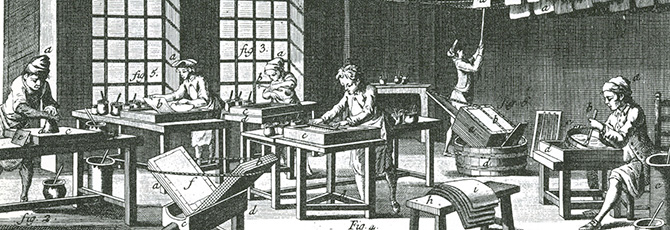The history of paper from the beginning up to the first industry

Paper making is one of the inventions by Chinese. 105 A.D. is often cited as the year in which papermaking was invented. In that year, historical records show that the invention of paper was reported to the Eastern Han Emperor Ho-di by Ts’ai Lun, an official of the Imperial Court.
Recent archaeological investigations, however, place the actual invention of papermaking some 200 years earlier. Ts’ai Lun broke the bark of a mulberry tree into fibres and pounded them into a sheet. Later it was discovered that the quality of paper could be much improved with the addition of rags hemp and old fish nets to the pulp. The paper was soon widely used in China and spread to the rest of world through the Silk Road.
An official history written some centuries later explained: in ancient times writing was generally on bamboo or on pieces of silk, which were then called ji. But silk being expensive and bamboo heavy, these twoich materials were not conveninet. Then Tsai Lun thought of using tree bark,n hemp, rags, and fish nets. In 105 he made a report to the emperor on the process of paper making, and received high praise for his ability. From this time paper has been in use everywhere and is called the “paper of Marquis Tsai.”
In few years, the Chinese began to use paper for writing. Around 600 A.D. woodblock printing was invented and by 740 A.D., The first printed newspaper was seen in China. To the east, papermaking moved to Korea, where production of paper began as early as the 6th century AD. Pulp was prepared from the fibers of hemp, rattan, mulberry, bamboo, rice straw, and seaweed. According to tradition, a Korean monk named Don-cho brought papermaking to Japan by sharing his knowledge at the Imperial Palace in approximately AD 610, sixty years after Buddhism was introduced in Japan.
Along the Silk Road, we learned that paper was introduced to Xinjiang area very early according to the archaeological records. The paper found at Kaochang, Loulan, Kusha, Kotan, and Dunhuang sites dated as early as the 2nd. century. The technique eventaully reached Tibet around 650 A.D. and then to India after 645 A.D. By the time Hsuan Tsang from China arrived to India in 671 A.D., paper was already widely used there.
For a long time the Chinese closely guarded the secret of paper manufacture and tried to eliminate other Oriental centers of production to ensure a monopoly. However in 751 A.D. the T’ang army was defeated by the Ottoman Turks at a mighty battle at the Talas River. Some Chinese soldiers and paper makers were captured and brought to Samarkand. The Arabs learned the paper making from the Chinese prisoners and built the first paper industry in Baghdad in 793 A.D. They, too, kept it a secret, and Europeans did not learn how to make paper until several centuries later.
The Egyptians learned the paper making from the Arabs during the early 10th century. Around 1100 A.D. paper arrived in Northern Africa and by 1150 A.D. it arrived to Spain as a result of the crusades and established the first paper industry in Europe. In 1453 A.D. Johann Gutenberg invents the printing press. The first paper industry in the North America was built in Philadelphia in 1690.
19th century advances in papermaking
Although cheaper than vellum, paper remained expensive, at least in book-sized quantities, through the centuries, until the advent of steam-driven paper making machines in the 19th century, which could make paper with fibres from wood pulp. Although older machines predated it, the Fourdrinier paper making machine became the basis for most modern papermaking. Nicholas Louis Robert of Essonnes, France, was granted a patent for a continuous paper making machine in 1799. At the time he was working for Leger Didot with whom he quarrelled over the ownership of the invention. Didot sent his brother-in-law, John Gamble, to meet Sealy and Henry Fourdrinier, stationers of London, who agreed to finance the project. Gamble was granted British patent 2487 on 20 October 1801. With the help particularly of Bryan Donkin, a skilled and ingenious mechanic, an improved version of the Robert original was installed at Frogmore, Hertfordshire, in 1803, followed by another in 1804. A third machine was installed at the Fourdriniers’ own mill at Two Waters. The Fourdriniers also bought a mill at St Neots intending to install two machines there and the process and machines continued to develop.
However, experiments with wood showed no real results in the late 18th-century and at the start of the 19th-century. By 1800, Matthias Koops (in London, England) further investigated the idea of using wood to make paper, and in 1801 he wrote and published a book titled Historical account of the substances which have been used to describe events, and to convey ideas, from the earliest date, to the invention of paper. His book was printed on paper made from wood shavings (and adhered together). No pages were fabricated using the pulping method (from either rags or wood). He received financial support from the royal family to make his printing machines and acquire the materials and infrastructure need to start his printing business. But his enterprise was short lived. Only a few years following his first and only printed book (the one he wrote and printed), he went bankrupt. The book was very well done (strong and had a fine appearance), but it was very costly.
Then in the 1830s and 1840s, two men on two different continents took up the challenge, but from a totally new perspective. Both Charles Fenerty and Friedrich Gottlob Keller began experiments with wood but using the same technique used in paper making; instead of pulping rags, they thought about pulping wood. And at about exactly the same time, by mid-1844, they announced that their findings. They invented a machine which extracted the fibres from wood (exactly as with rags) and made paper from it. Charles Fenerty also bleached the pulp so that the paper was white. This started a new era for paper making. By the end of the 19th-century almost all printers in the western world were using wood in lieu of rags to make paper.
Together with the invention of the practical fountain pen and the mass produced pencil of the same period, and in conjunction with the advent of the steam driven rotary printing press, wood based paper caused a major transformation of the 19th century economy and society in industrialized countries. With the introduction of cheaper paper, schoolbooks, fiction, non-fiction, and newspapers became gradually available by 1900. Cheap wood based paper also meant that keeping personal diaries or writing letters became possible and so, by 1850, the clerk, or writer, ceased to be a high-status job.
The original wood-based paper was acidic due to the use of alum and more prone to disintegrate over time, through processes known as slow fires. Documents written on more expensive rag paper were more stable. Mass-market paperback books still use these cheaper mechanical papers (see below), but book publishers can now use acid-free paper for hardback and trade paperback books.
